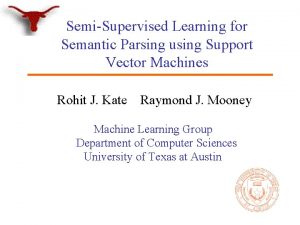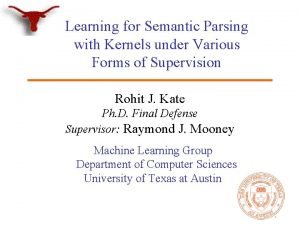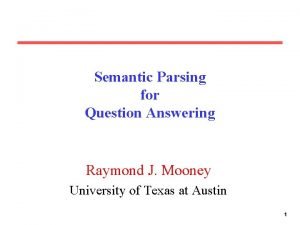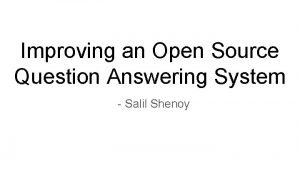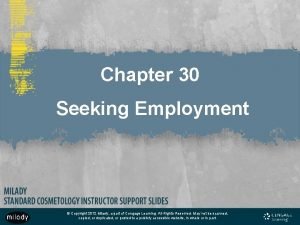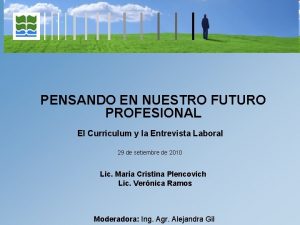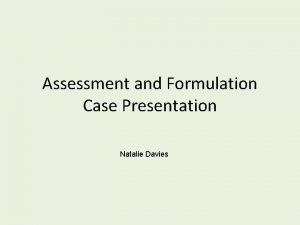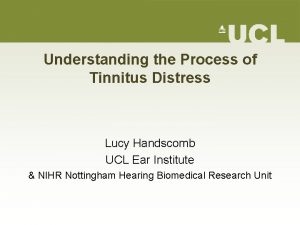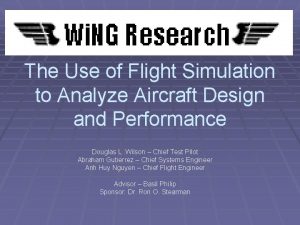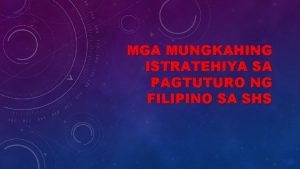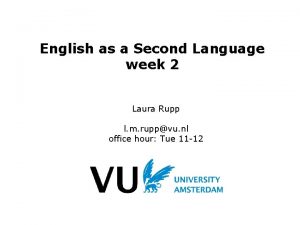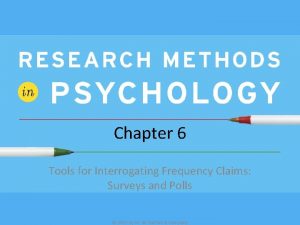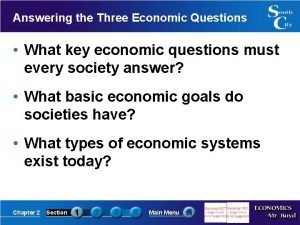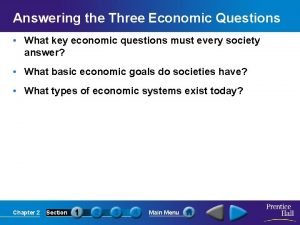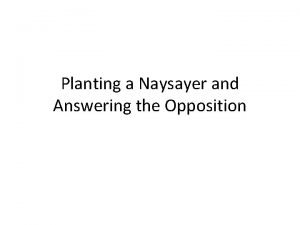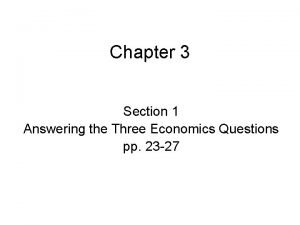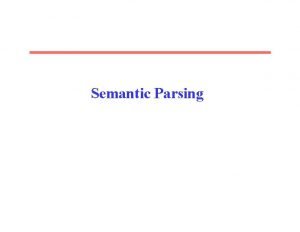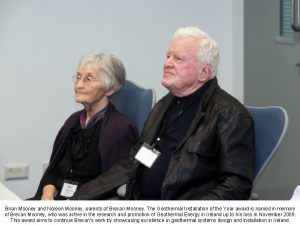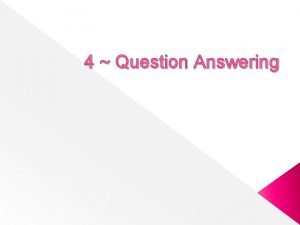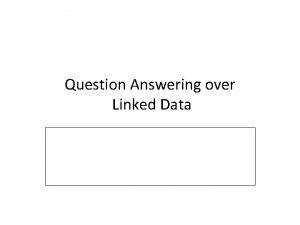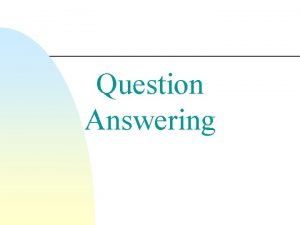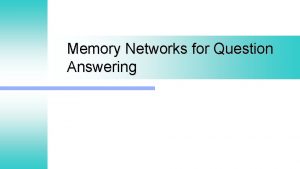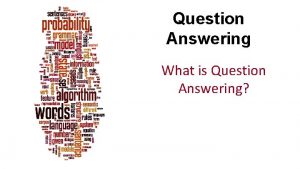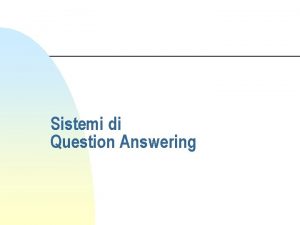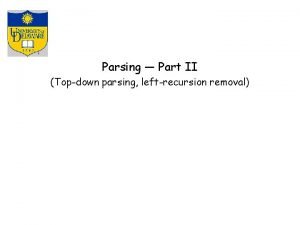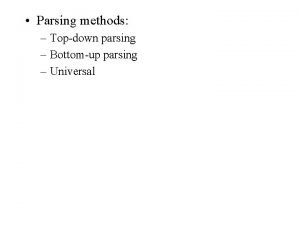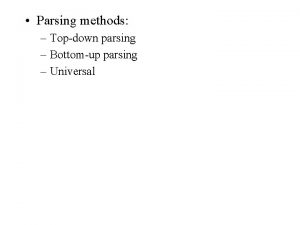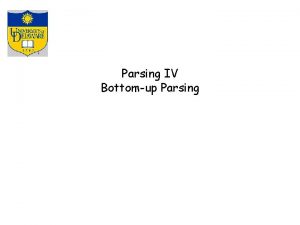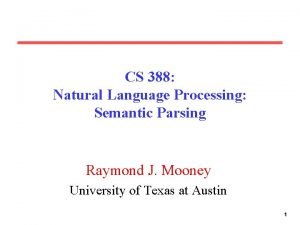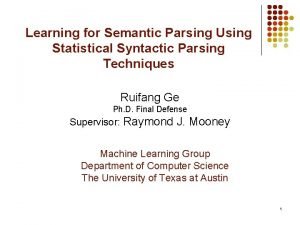Semantic Parsing for Question Answering Raymond J Mooney











![Experimental Corpora • Geo. Query [Zelle & Mooney, 1996] – – 250 queries for Experimental Corpora • Geo. Query [Zelle & Mooney, 1996] – – 250 queries for](https://slidetodoc.com/presentation_image_h/26a6a337e86241166afaaf5e236ad1ea/image-12.jpg)






- Slides: 18

Semantic Parsing for Question Answering Raymond J. Mooney University of Texas at Austin 1

Semantic Parsing • Semantic Parsing: Transforming natural language (NL) sentences into completely formal logical forms or meaning representations (MRs). • Sample application domains where MRs are directly executable by another computer system to perform some task. – Database/knowledge-graph queries – Robot command language 2

Geoquery: A Database Query Application • Query application for U. S. geography database containing about 800 facts [Zelle & Mooney, 1996] Which rivers run through the states bordering Texas? Arkansas, Canadian, Cimarron, Gila, Mississippi, Rio Grande … Answer Semantic Parsing answer(traverse(next_to(stateid(‘texas’)))) Query 3

Predicate Logic Query Language • Most existing work on computational semantics is based on predicate logic What is the smallest state by area? answer(x 1, smallest(x 2, (state(x 1), area(x 1, x 2)))) x 1 is a logical variable that denotes “the smallest state by area” 4

Functional Query Language (Fun. QL) • Transform a logical language into a functional, variable-free language (Kate et al. , 2005) What is the smallest state by area? answer(x 1, smallest(x 2, (state(x 1), area(x 1, x 2)))) answer(smallest_one(area_1(state(all)))) 5

Learning Semantic Parsers • Manually programming robust semantic parsers is difficult due to the complexity of the task. • Semantic parsers can be learned automatically from sentences paired with their logical form. NL MR Training Exs Natural Language Semantic-Parser Learner Semantic Parser Meaning Rep 6

Compositional Semantics • Approach to semantic analysis based on building up an MR compositionally based on the syntactic structure of a sentence. • Build MR recursively bottom-up from the parse tree. Build. MR(parse-tree) If parse-tree is a terminal node (word) then return an atomic lexical meaning for the word. Else For each child, subtreei, of parse-tree Create its MR by calling Build. MR(subtreei) Return an MR by properly combining the resulting MRs for its children into an MR for the overall parse-tree.

Composing MRs from Parse Trees What is the capital of Ohio? S answer(capital(loc_2(stateid('ohio')))) NP WP What VP capital(loc_2(stateid('ohio'))) answer() NP V capital(loc_2(stateid('ohio'))) VBZ DT N capital() PP loc_2(stateid('ohio')) is the capital IN loc_2() NP stateid('ohio') capital() of loc_2() NNPstateid('ohio') Ohio stateid('ohio') 8

Disambiguation with Compositional Semantics • The composition function that combines the MRs of the children of a node, can return if there is no sensible way to compose the children’s meanings. • Could compute all parse trees up-front and then compute semantics for each, eliminating any that ever generate a semantics for any constituent. • More efficient method: – When filling (CKY) chart of syntactic phrases, also compute all possible compositional semantics of each phrase as it is constructed and make an entry for each. – If a given phrase only gives semantics, then remove this phrase from the table, thereby eliminating any parse that includes this meaningless phrase.

Composing MRs from Parse Trees What is the capital of Ohio? S NP WP What VP NP V VBZ is DT PP N the capital IN loc_2() NP riverid('ohio') of loc_2() NNPriverid('ohio') Ohio riverid('ohio') 10

Composing MRs from Parse Trees What is the capital of Ohio? S VP NP WP What NP capital() V PPloc_2(stateid('ohio')) VBZ DT N capital() IN loc_2() NP stateid('ohio') NNP of is the capital() loc_2() Ohio stateid('ohio')
![Experimental Corpora Geo Query Zelle Mooney 1996 250 queries for Experimental Corpora • Geo. Query [Zelle & Mooney, 1996] – – 250 queries for](https://slidetodoc.com/presentation_image_h/26a6a337e86241166afaaf5e236ad1ea/image-12.jpg)
Experimental Corpora • Geo. Query [Zelle & Mooney, 1996] – – 250 queries for the given U. S. geography database 6. 87 words on average in NL sentences 5. 32 tokens on average in formal expressions Also translated into Spanish, Turkish, & Japanese. 12

Experimental Methodology • Evaluated using standard 10 -fold cross validation • Correctness – CLang: output exactly matches the correct representation – Geoquery: the resulting query retrieves the same answer as the correct representation • Metrics 13

Precision Learning Curve for Geo. Query 14

Recall Learning Curve for Geoquery 15

Precision Learning Curve for Geo. Query (WASP) 16

Recall Learning Curve for Geo. Query (WASP) 17

Conclusions • Semantic parsing maps NL sentences to completely formal computer language. • Semantic parsers can be effectively learned from supervised corpora consisting of only sentences paired with their formal representations. • Can reduce supervision demands by training on questions and answers rather than formal representations. – Results on Free. Base queries and queries to corpora of web tables. • Full question answering is finally taking off as an application due to: – Availability of large scale, open databases such as Free. Base, DBPedia, Google Knowledge Graph, Bing Satori – Availability of speech interfaces that allow more natural entry of full NL questions.
 Semantic parsing
Semantic parsing Semantic parsing
Semantic parsing Semantic parsing
Semantic parsing Answering
Answering Milady chapter 30 theory workbook answers
Milady chapter 30 theory workbook answers Cual es la sexta regla del manual de mooney
Cual es la sexta regla del manual de mooney Beck longitudinal formulation 1979
Beck longitudinal formulation 1979 Padesky and mooney 1990
Padesky and mooney 1990 Mooney 305 rocket
Mooney 305 rocket Costa levels of questions
Costa levels of questions Mungkahing teknik
Mungkahing teknik Semantic differential question
Semantic differential question Semantic differential question
Semantic differential question Chapter 2 section 1 answering the three economic questions
Chapter 2 section 1 answering the three economic questions Present continuous for future
Present continuous for future Chapter 2 section 1 answering the three economic questions
Chapter 2 section 1 answering the three economic questions Naysayer paragraph example
Naysayer paragraph example Panicking spelling
Panicking spelling Economics chapter 3 section 1 answer key
Economics chapter 3 section 1 answer key
